Fayoum Oasis
Yesterday I went with Johanna Freeman and Joseph Hannah out to Kom Oshim, 30 kilometers from Fayoum. Jo is Australian and has been working with a development group here for 3 ½ years. Her husband Joseph is Manager of Marketing and Administration in the trade area of the Australian Embassy (Austrade). Jo is involved with setting up an export business based around local pottery - simple pots, most of them unglazed, some very big indeed. Next time you shop at Northcote Pots in Melbourne, look carefully at the pots and remember how far they have traveled, in every way.
I left the house at ten and walked up to the nearby supermarket which was my pickup point. Bob was somewhat off-colour – unless your favourite colour is a delicate green – thanks to a bug picked up in his recent travels. He was confined to the house for the day. I had spent the day before driving around Zamalek in the Cherokee in case I had to drive, but was relieved when told that there was enough space without my vehicle. I had had a face-to-face encounter with a Humvee in a very narrow street with cars parked down each side, which meant I had had to back out of the street through such a narrow hole that I was a bit astounded that the Humvee could get through without denting every car it passed.
Seven of us from the embassy piled into two vehicles and left. Our driver was Hercules, a good looking young Nubian. There was a brief moment where I didn’t believe that I had heard his name correctly, but apparently it is quite a common name in the Sudan.
I was lucky. I was in a car with a working air conditioner and two friends from the Embassy. After about half an hour we started the long slow climb up to the desert escarpment level. Usually in a car we barely notice that we are even going up. Today we did, as Hercules was clearly struggling to get it up the hills. We tried turning the air conditioning off, and that didn’t help much – certainly not with climate control with the temperature in the desert well up in the late thirties. By the last third of the hill I was mentally urging the car on with the “I think I can, I think I can” mantra.
Things seemed to improve a little as we leveled out, but then up we went again and the car slowed and slowed. Back on a flat stretch again Hercules pulled over. He got out, walked ahead of the car a little way and picked up a piece of wood. Next minute he was wedging something to do with the petrol pump, roaring the accelerator, and it sounded a little better. It was actually quite an interesting place to stop. Not because of the desert, as in this place it simply stretched away with gravel as far as the eye could see. There had obviously been a problem here, and some truck had lost a large load of packed cheese, of the circular, wedge-packed kind. Not only that, but it had been on fire. Beside the road, for several metres out into the desert, stretched a pile of cheese packs in varying levels of disintegration and charcoal. It must have smelt like grilled cheese for days after this lot went up.
We took off again. It didn’t take long for us to realise that this car was not going to get to Fayoum today.
A phone call to the other car had them waiting for us to limp to them. Then all of us piled into one car. It was, luckily, a big car – a long station wagon with a third row of seats in the very back, but it was hot (no air-conditioning) and especially for those in the very back. It was fun though – with that rather hectic fun that happens when everyone decides to relax and just see what will happen. Chocolate bars and icy cold boxed drinks probably helped. We had the windows open, and because we were together Jo could brief us on the project as she drove. At one point we were overtaken by a pickup truck full of cows. I turned as they went past to see the passenger in the front climbing out through the window at speed, to check on the bovines in the back.
Egypt is never, ever, boring.
We turned off the highway and bumped over rough dirt tracks to the pottery. This is a hired property, with Ahmed, who runs the pottery, paying for the use of old chicken houses. These were simply walled, and in many places the walls had been made out of broken pots. The roof was wooden support beams – very flimsy – with woven bamboo roofing, often with loose leaves hanging down. It was surprisingly cool inside compared with the heat outside.
We watched a potter (I didn’t get his name) take a lump of clay, plunk it down expertly in the very centre of his wheel, and proceed to pull and smooth it into a large pot. I have seen it many times before, but never quite get over the awe at watching something appear from a lump of mud – and it seems so quick to a quilter.
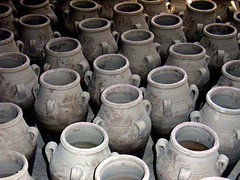
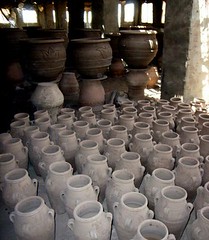
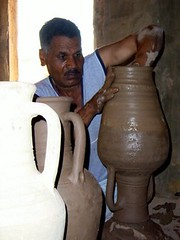
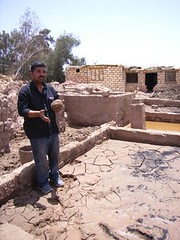
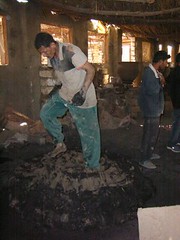
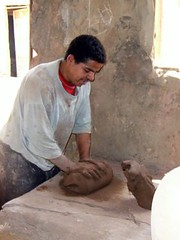
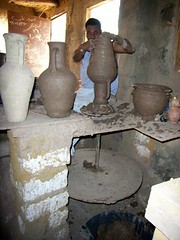
We were walked through the process – the clay cleaned, mixed with water and left to dry down to just cracking stage in large outdoor pans.
Then the clay is brought in, stacked in large piles, stacked and coated with a thick dusting of charcoal which, we were told, strengthens the clay. Then a barefooted man walks around and around on top of it as part of the initial wedging process. He forces his feet down into it to mix in the charcoal and it creams up between large splayed toes. The men’s clothes were almost rags, and I was briefly worried that that was all they had - but I guess I wouldn’t wear my best to work in a pottery either.
We watched several pots made, and I was fascinated by the obvious love of handling the slick wet clay, and the half smile on the potter as he watched our reactions to different parts of the process. The big wheel under his feet drove the wheel with the pot on it, so he kept one foot on the wheel stroking it around as his hands formed the clay. He was so proud of his work – as were all the men at the different parts of the process. They start at simpler things like the wedging and unloading kilns, and there are now thirty potters who work on wheels, and another twenty with Mohammed at his special process.
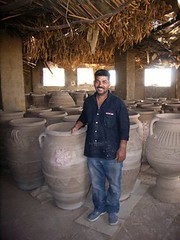
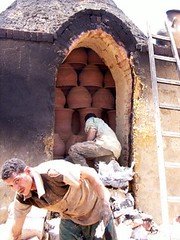
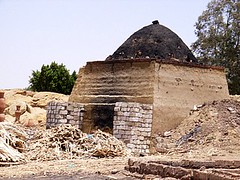
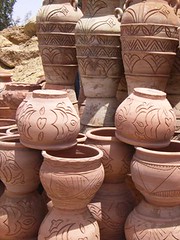
We inspected the kilns, and watched as men using only a small piece of corrugated cardboard to protect their hands, and with bare feet despite the piles of cracked and broken reject pottery everywhere, unloaded obviously hot large pots from a very fully stacked kiln.
This was the equivalent of our Saturday, and so not many potters were there. One man, Mohammed, had come in especially for our visit. Jo hinted that his work was really interesting as we headed for a separate hut.
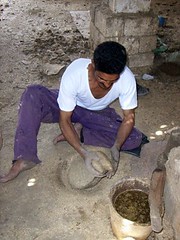
Mohammed sat on the dirt, and with a round hollow in the dirt in front of him. He used fine chaff in the hollow in the way that we would dust a surface with flour before kneading bread, and dropped a piece of clay onto it. He then used a round hammer – which looked just like the fuller we used to grind pigments in art school (before giving up and going out to buy paint in tubes from the shop). He kept a hand under the clay and belted it with the hammer rhythmically – and we watched in amazement as a pot grew and curled up over his hand and the hammer – almost perfectly spherical, if only he hadn’t needed to get his hand and hammer into it. He would stop from time to time to dust with more chaff, then reached for a long flat strap and moved to slapping from the outside with his hand inside.
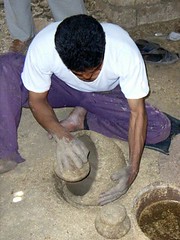
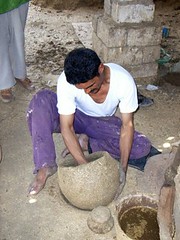
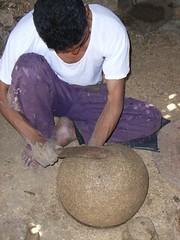
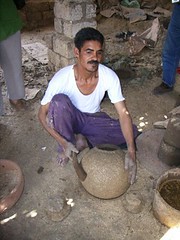
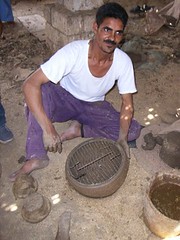
He was making vessels which would hold fire. We had noticed the men boiling a pot on a small fire in a pottery vessel back in the other hut – and this was one of Mohammed’s. Apparently you can’t light fires in wheel-turned clay, or it cracks and breaks. This way of making a vessel with the chaff and hammer results in a much stronger pot which can take heat. They make a range of chimney vessels for outside heating with a large oval hole in the base. The holes are not wasted either – they are fired after they are cut out and used in building walls. They also make a range of very clever deep round bowls which are used as small barbecues, with a metal grill on top.
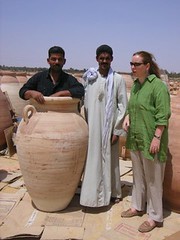
Ahmed in the pot, Mohammed and Jo
Check the Fayoum Oasis site.
Ahmed showed us around. He lost his job when potteries in Old Cairo were closed down as people objected to the wood smoke of the kilns. He moved north and set up the pottery in the poorest region of one of the poorest governorates of all of Egypt. He started to teach people to make pots. Jo and her group made contact with him to help with the development and the export of his products. He is an unusual man – a real entrepreneur with vision to see that things can change, and the will to try to be the person to make the changes. Mohammed runs the other side of the business as the number two. Usually fifteen people work with Mohammed, and about thirty on the wheels with Ahmed. They have also set up a candle making venture, making candles to go into small square posts, in beautiful golds and reds and this is work that they have been able to get women to do.
We had a late lunch (though three is not late by local standards) at a beautiful resort hotel on a lake in Shak Bouk. It was a really interesting day.
I left the house at ten and walked up to the nearby supermarket which was my pickup point. Bob was somewhat off-colour – unless your favourite colour is a delicate green – thanks to a bug picked up in his recent travels. He was confined to the house for the day. I had spent the day before driving around Zamalek in the Cherokee in case I had to drive, but was relieved when told that there was enough space without my vehicle. I had had a face-to-face encounter with a Humvee in a very narrow street with cars parked down each side, which meant I had had to back out of the street through such a narrow hole that I was a bit astounded that the Humvee could get through without denting every car it passed.
Seven of us from the embassy piled into two vehicles and left. Our driver was Hercules, a good looking young Nubian. There was a brief moment where I didn’t believe that I had heard his name correctly, but apparently it is quite a common name in the Sudan.
I was lucky. I was in a car with a working air conditioner and two friends from the Embassy. After about half an hour we started the long slow climb up to the desert escarpment level. Usually in a car we barely notice that we are even going up. Today we did, as Hercules was clearly struggling to get it up the hills. We tried turning the air conditioning off, and that didn’t help much – certainly not with climate control with the temperature in the desert well up in the late thirties. By the last third of the hill I was mentally urging the car on with the “I think I can, I think I can” mantra.
Things seemed to improve a little as we leveled out, but then up we went again and the car slowed and slowed. Back on a flat stretch again Hercules pulled over. He got out, walked ahead of the car a little way and picked up a piece of wood. Next minute he was wedging something to do with the petrol pump, roaring the accelerator, and it sounded a little better. It was actually quite an interesting place to stop. Not because of the desert, as in this place it simply stretched away with gravel as far as the eye could see. There had obviously been a problem here, and some truck had lost a large load of packed cheese, of the circular, wedge-packed kind. Not only that, but it had been on fire. Beside the road, for several metres out into the desert, stretched a pile of cheese packs in varying levels of disintegration and charcoal. It must have smelt like grilled cheese for days after this lot went up.
We took off again. It didn’t take long for us to realise that this car was not going to get to Fayoum today.
A phone call to the other car had them waiting for us to limp to them. Then all of us piled into one car. It was, luckily, a big car – a long station wagon with a third row of seats in the very back, but it was hot (no air-conditioning) and especially for those in the very back. It was fun though – with that rather hectic fun that happens when everyone decides to relax and just see what will happen. Chocolate bars and icy cold boxed drinks probably helped. We had the windows open, and because we were together Jo could brief us on the project as she drove. At one point we were overtaken by a pickup truck full of cows. I turned as they went past to see the passenger in the front climbing out through the window at speed, to check on the bovines in the back.
Egypt is never, ever, boring.
We turned off the highway and bumped over rough dirt tracks to the pottery. This is a hired property, with Ahmed, who runs the pottery, paying for the use of old chicken houses. These were simply walled, and in many places the walls had been made out of broken pots. The roof was wooden support beams – very flimsy – with woven bamboo roofing, often with loose leaves hanging down. It was surprisingly cool inside compared with the heat outside.
We watched a potter (I didn’t get his name) take a lump of clay, plunk it down expertly in the very centre of his wheel, and proceed to pull and smooth it into a large pot. I have seen it many times before, but never quite get over the awe at watching something appear from a lump of mud – and it seems so quick to a quilter.







We were walked through the process – the clay cleaned, mixed with water and left to dry down to just cracking stage in large outdoor pans.
Then the clay is brought in, stacked in large piles, stacked and coated with a thick dusting of charcoal which, we were told, strengthens the clay. Then a barefooted man walks around and around on top of it as part of the initial wedging process. He forces his feet down into it to mix in the charcoal and it creams up between large splayed toes. The men’s clothes were almost rags, and I was briefly worried that that was all they had - but I guess I wouldn’t wear my best to work in a pottery either.
We watched several pots made, and I was fascinated by the obvious love of handling the slick wet clay, and the half smile on the potter as he watched our reactions to different parts of the process. The big wheel under his feet drove the wheel with the pot on it, so he kept one foot on the wheel stroking it around as his hands formed the clay. He was so proud of his work – as were all the men at the different parts of the process. They start at simpler things like the wedging and unloading kilns, and there are now thirty potters who work on wheels, and another twenty with Mohammed at his special process.




We inspected the kilns, and watched as men using only a small piece of corrugated cardboard to protect their hands, and with bare feet despite the piles of cracked and broken reject pottery everywhere, unloaded obviously hot large pots from a very fully stacked kiln.
This was the equivalent of our Saturday, and so not many potters were there. One man, Mohammed, had come in especially for our visit. Jo hinted that his work was really interesting as we headed for a separate hut.

Mohammed sat on the dirt, and with a round hollow in the dirt in front of him. He used fine chaff in the hollow in the way that we would dust a surface with flour before kneading bread, and dropped a piece of clay onto it. He then used a round hammer – which looked just like the fuller we used to grind pigments in art school (before giving up and going out to buy paint in tubes from the shop). He kept a hand under the clay and belted it with the hammer rhythmically – and we watched in amazement as a pot grew and curled up over his hand and the hammer – almost perfectly spherical, if only he hadn’t needed to get his hand and hammer into it. He would stop from time to time to dust with more chaff, then reached for a long flat strap and moved to slapping from the outside with his hand inside.





He was making vessels which would hold fire. We had noticed the men boiling a pot on a small fire in a pottery vessel back in the other hut – and this was one of Mohammed’s. Apparently you can’t light fires in wheel-turned clay, or it cracks and breaks. This way of making a vessel with the chaff and hammer results in a much stronger pot which can take heat. They make a range of chimney vessels for outside heating with a large oval hole in the base. The holes are not wasted either – they are fired after they are cut out and used in building walls. They also make a range of very clever deep round bowls which are used as small barbecues, with a metal grill on top.

Ahmed in the pot, Mohammed and Jo
Check the Fayoum Oasis site.
Ahmed showed us around. He lost his job when potteries in Old Cairo were closed down as people objected to the wood smoke of the kilns. He moved north and set up the pottery in the poorest region of one of the poorest governorates of all of Egypt. He started to teach people to make pots. Jo and her group made contact with him to help with the development and the export of his products. He is an unusual man – a real entrepreneur with vision to see that things can change, and the will to try to be the person to make the changes. Mohammed runs the other side of the business as the number two. Usually fifteen people work with Mohammed, and about thirty on the wheels with Ahmed. They have also set up a candle making venture, making candles to go into small square posts, in beautiful golds and reds and this is work that they have been able to get women to do.
We had a late lunch (though three is not late by local standards) at a beautiful resort hotel on a lake in Shak Bouk. It was a really interesting day.


4 Comments:
Dear Jenny
Thanks for letting us know how to post comments to your wonderful posts. Your shopping trips just leave me breathless. I would kill for that red silk and those dresses! Maybe that is slightly overstated, but you get my drift.
I tried pottery once and was so hopeless that I stand in awe of anyone who can do it and do it as well as these men.
I am loving all your posts, but you know I loved the other ones as well.
LaVone - Perth
Dear Jenny
Have just returned from a weekend holiday in Hobart with my 2 daughters - a wonderful get together, to find that you have written pages of fascination for me to dream with. Who needs to travel when you make it all so vivid and exciting?
I hope this will become a book some day - a best seller for sure.
Cheers
Liz
Hi Jenny, keep up the fantastic work - it is my office lunchtime read. We recently had a weekend away and I attempted some photos in your style, wish I could send you one just for contrast - autumn near Beechworth!
Rosalee
Langwarrin Vic
Jenny
Small world. I worked with those potters and Jo for three months, from February till end of April 2005. I have no idea who you are, but we almost met. Stumbled on your page 2 years later. Muhammad looked younger in your photos than I remember, but oh well. I miss that guy. I miss Egypt. It really is magical. Did you meet Douglas? Wonder how he's doing...
Post a Comment
<< Home